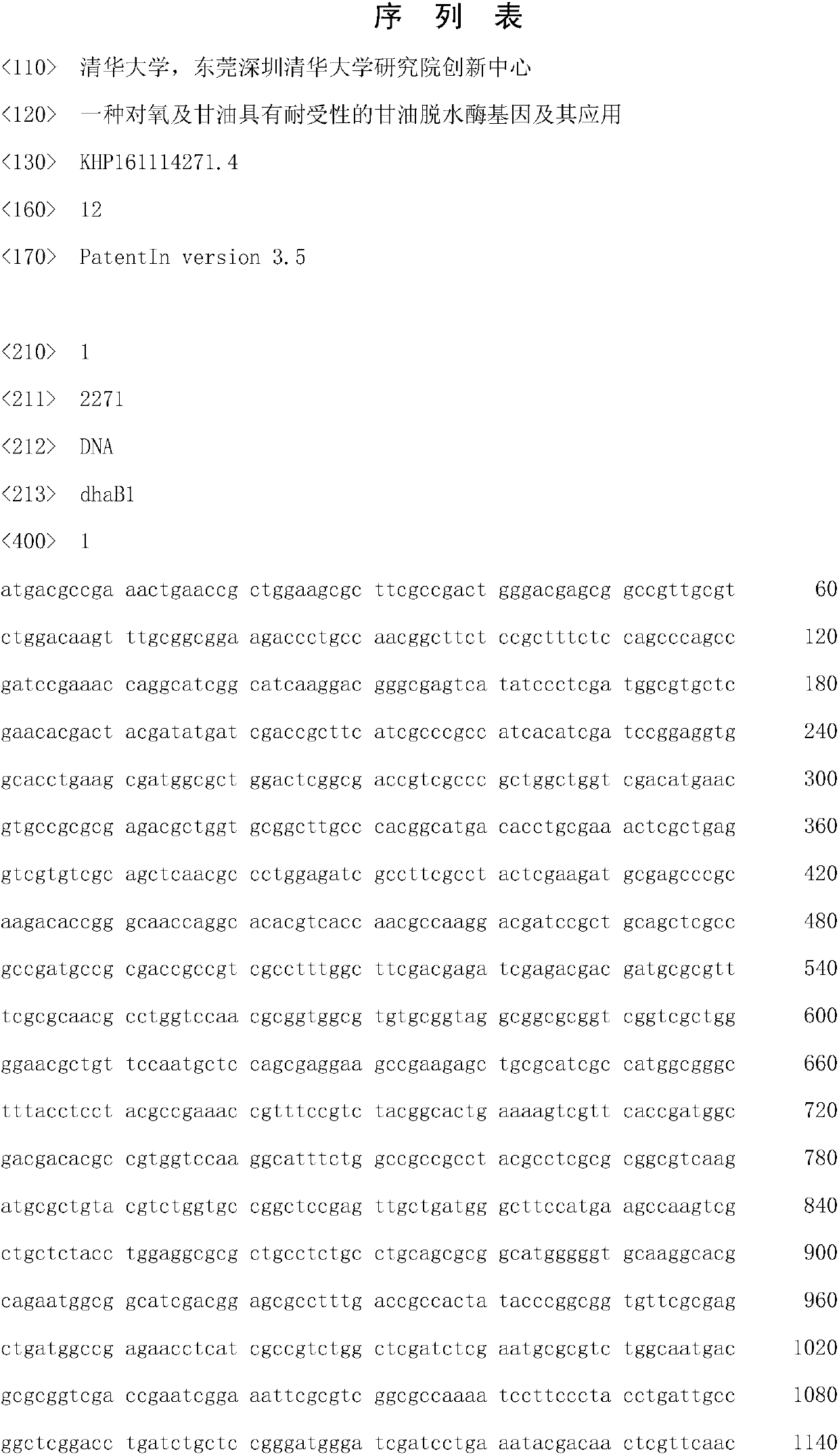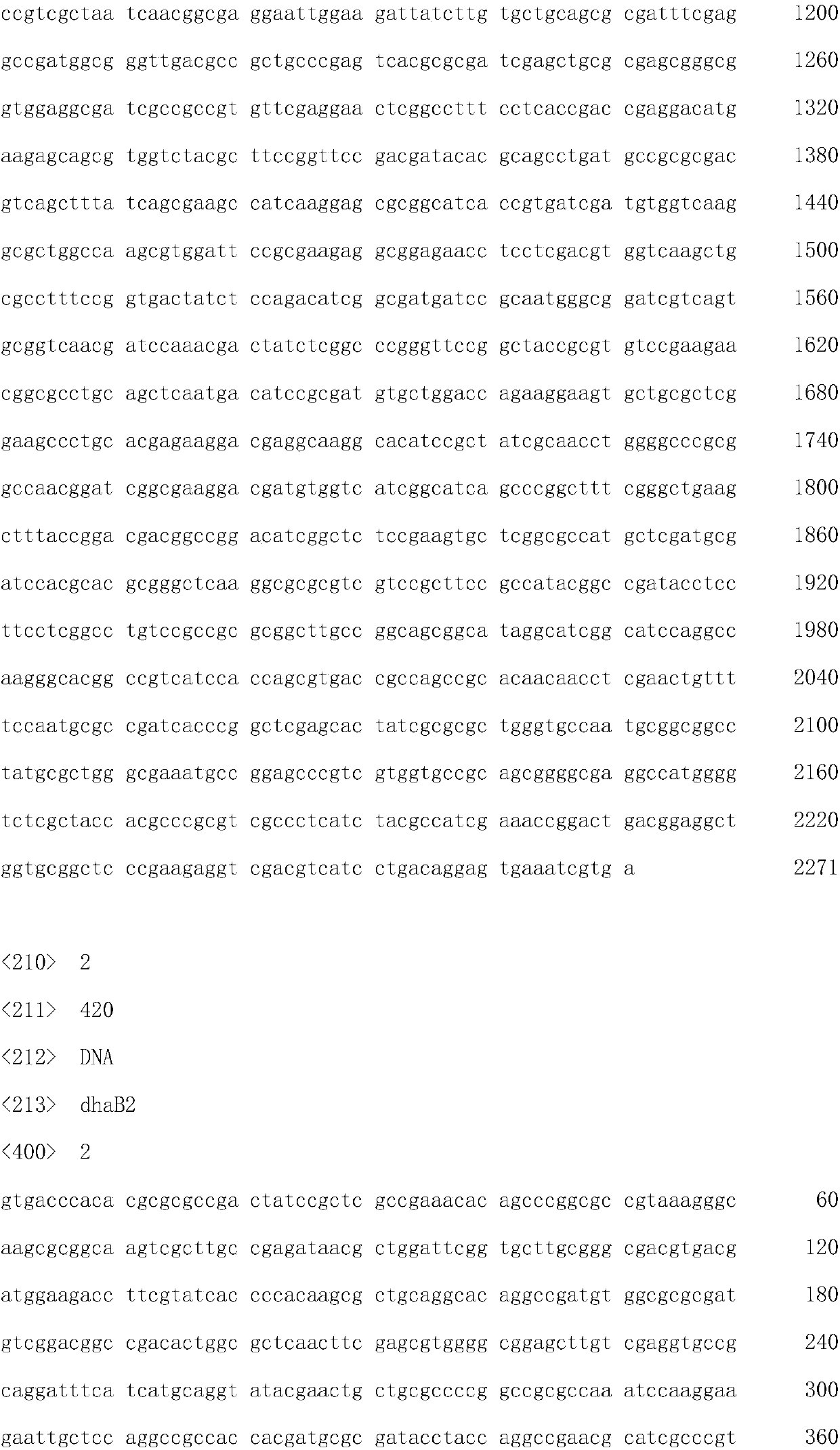Glycerol dehydratase gene resistant to oxygen and glycerin and application thereof
A glycerol dehydratase, gene technology, applied in the application, genetic engineering, carbon-oxygen lyase and other directions, can solve the problem of reducing the enzymatic activity of glycerol dehydratase, and achieve the effect of high catalytic activity
- Summary
- Abstract
- Description
- Claims
- Application Information
AI Technical Summary
Problems solved by technology
Method used
Image
Examples
Embodiment 1
[0026] Example 1 Expression of glycerol dehydratase gene dhaB1B2 derived from Rhizobium japonicus and verification of its catalytic performance
[0027] Using the genome of Rhizobium loti as a template, PCR was performed with primers dhaB-F (AAGCTTGTCGACGGAGCTCGAATTCTCAGAAGCGGAATGTGAAAAGGCC) and dhaB-R (CTGGTGCCGCGCGGCAGCCATATGatgACGCCGAAACTGAACCG) to obtain about 2.7kb of the dhaB1B2 gene and purify the PCR product. The dhaB1B2 gene only contains 2 subunits, α subunit and β subunit, dhaB1 gene is α subunit, its nucleotide sequence is shown in SEQ ID NO.1, dhaB2 gene is β subunit, its nucleotide sequence As shown in SEQ ID NO.2.
[0028] Using the genome of Klebsiella pneumoniae HR526 (Klebsiella pneumoniae) as a template, PCR was carried out with primers gld-F (AAGCTTGTCGACGGAGCTCGAATTCTTAGCTTCCTTTACGCAGCTTATGC) and gld-R (CTGGTGCCGCGCGGCAGCCATATGatgAAAAAGATCAAAACGATTTGCAGTACTGG) as primers to obtain a gldABC gene product of about 2.0 kb and purified by PCR.
[0029] The exp...
Embodiment 2
[0035] Embodiment 2 utilizes the glycerol dehydratase gene derived from Rhizobium japonicum to improve the output of 1,3-propanediol
[0036] The pET-dhaB1B2 and pET-gldABC of Example 1 were digested with NdeI and EcoRI respectively and then ligated to the plasmid pEC-K18 (purchased from Addgene), and the obtained plasmids were named pEC-dhaB1B2 and pEC-gldABC. pEC-dhaB1B2 and pEC-gldABC were respectively electrotransformed into Klebsiella pneumoniae HR526 (electroporation conditions were voltage 1.8KV, 1mm electroporation cup), and the recombinant bacteria were obtained by screening on 50mg / L kanamycin LB plate, They were named Kp / pEC-dhaB1B2 and Kp / pEC-gldABC, respectively.
[0037] The wild-type Klebsiella pneumoniae HR526 and the two recombinant strains were respectively cultured in the fermentation medium for 48 hours (37° C., 150 rpm), and the production of 1,3-propanediol was detected. The composition of the fermentation medium is (g / L): glycerol 30, (NH 4 ) 2 SO 4 ...
Embodiment 3
[0039] Example 3 Utilization of the glycerol dehydratase gene derived from Rhizobium japonicum to increase the production of 3-hydroxypropionic acid
[0040] Using the genome of Escherichia coli K12 as a template, PCR was performed with primers aldH-F (tgcatgcctgcaggtcgactCTGACGTTCACAAACTGCATATATCTGATAGAC) and aldH-R (TATATCTCCTTtcaGGCCTCCAGGCTTATCCA) as primers to obtain and purify the aldH fragment of the 3-hydroxypropionate dehydrogenase gene (sequence shown in seq 3 Show).
[0041] The aldH gene was connected to the pET-dhaB1B2 and pET-gldABC prepared in Example 1 using the Gibson Assembly kit (NEB), respectively, and the obtained recombinant plasmids were named pET-dhaB1B2-aldH and pET-gldABC-aldH. These two plasmids were further transformed into Escherichia coli BL21 (DE3) by chemical transformation method, and the recombinant bacteria were obtained by screening on 50mg / L kanamycin LB plate, named BL21 / pET-dhaB1B2-aldH and BL21 / pET-dhaB2-aldH respectively. BL21 / pET-gldA...
PUM
 Login to View More
Login to View More Abstract
Description
Claims
Application Information
 Login to View More
Login to View More - R&D
- Intellectual Property
- Life Sciences
- Materials
- Tech Scout
- Unparalleled Data Quality
- Higher Quality Content
- 60% Fewer Hallucinations
Browse by: Latest US Patents, China's latest patents, Technical Efficacy Thesaurus, Application Domain, Technology Topic, Popular Technical Reports.
© 2025 PatSnap. All rights reserved.Legal|Privacy policy|Modern Slavery Act Transparency Statement|Sitemap|About US| Contact US: help@patsnap.com



